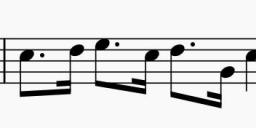French baroque eight-notes(quavers)
-
There is the tradition of notes inégales, which is 1) very strictly regulated (would only apply to the first beat in your example, since it contains stepwise motion) and 2) would rarely approach the 2:1 ratio in sharpness, let alone 3:1. Unfortunately, it is often caricatured by well-meaning performers who want to demonstrate to those "in the know" that they're aware of the convention.
-
I was taught that the rhythm is only inégal when the motion is stepwise, so the eighths on beat 3& in your example would be straight. I didn't study the primary sources and took these points on my organ teacher's word, but if I remember correctly, where there is melody and accompaniment, the inégal can be omitted in the accompaniment, and if there is a figure such as an eighth and two sixteenths in the melody (in stepwise motion), it becomes dotted eighth with 32nds. It usually affects eighth notes, and I was under the impression that inégal between sixteenths is completely at the performer's discretion. Again, I haven't studied the sources and can't say whether this reflects current scholarship.Thanked by 1Lars
-
The tradition of the Notes Inegal is that eight note groups have flexibility. The can be straight (mesure) or Coule - short long or Loure - long short. As I understand it (I am no authority) the interval doesen't matter - after all, in the above example, if you performed the stepwise notes with inegal and the larger intervals without, I would think it would sound rather silly/ Numerous written out examples of unequal eight note skips can be found.
-
As I understand it (I am no authority) the interval doesen't matter - after all, in the above example, if you performed the stepwise notes with inegal and the larger intervals without, I would think it would sound rather silly/ Numerous written out examples of unequal eight note skips can be found.
Whether you think it sounds silly or not, that is the tradition - additionally, the inequality is much, much more subtle than 3:1.
Furthermore, the tradition specifically only applied to equal notes, so written-out dotted pairs would be automatically exempt and not pertinent to this particular convention. -
Which brings us somewhat later to the performance practice of double-dotting dotted pairs.,,, written-out dotted pairs would be automatically exempt and not pertinent to this particular convention.
-
Actually, there is no documentary evidence for double-dotting as a matter of course prior to the Galant, and certainly none to be connected to a "French Overture" style. It was a twentieth-century concoction by Arnold Dolmetsch based on unrelated snippets from Galant authors which was somehow supposed to form the foundation of a unified and consistent style.
Of course, in the Baroque the soloist enjoyed almost unlimited license to modify what was printed—but what specifically was printed was always very clear.Thanked by 1Lars -
As with ornaments, some composers were clear on what they wanted and did not approve of modifications. For others, it was left up to the individual performer. Rigidity could prove to be the enemy of beautiful performance. See what works in individual compositions. They were French, not Germans. Some of us are thankful for that.
-
For this and similar matters consult French Organ Music in the Reign of Louis XIV.
This is a relatively recent and thorough study by David Ponsford (Cambridge).
The notes inegales occur only on the quickest note values in a given piece, and, as noted above, generally not on skips. Every organist should have Ponsford's book! -
I have it and it's good. However, there was French organ music after Louis XIV, as well.
-
.
-
(Purple) Yes, Charles, there was (and is) -
but, as the person who once was asked if he liked the music of Richard Wagner answered 'well, he has his moments, but ohhh! the spaces in between'. -
We are not even to the age of Wagner. Louis XIV died in 1715. Couperin overlapped him but lived some years beyond him. Claude Balbastre was born in 1724, nine years after the death of Louis XIV. If I remember correctly - always more questionable with the passage of time - French music did not move into the Romantic era until Napoleon.
-
.
-
I meant to add the other day, before the inevitable distractions occurred... When the French Revolution started, it was about 50 years later before any French organs were once again built. Much can happen in 50 years and the new organs sounded nothing like the old ones. Music style had changed totally, as well.
-
Charles,
Nothing beautiful could be created by the Revolution, but some seedlings were planted during the worst of troubles. -
True. The difference between the American and French Revolution is that the American Revolution wanted to build something better. The French wanted to destroy everything.Thanked by 1M. Jackson Osborn
Welcome to the MusicaSacra Forum!
To participate in the discussions on Catholic church music, sign in or register as a forum member, The forum is a project of the Church Music Association of America.
Categories
- All Discussions21,169
- General Music Discussion8,244
- Job Openings204
- Management of Music Programs851
- Choral Matters534
- Church Documents and Rubrics526
- CMAA Notes304
- Events720
- For Newcomers: Read First26
- Sacred Polyphony547
- Hymnody872
- Gregorian Chant: General2,703
- ↳ Graduale Romanum and Liber Usualis369
- ↳ Graduale Simplex60
- ↳ Semiology63
- Vernacular Plainsong696
- Anglican Use and Anglican Chant68
- Organ, Other Instruments and Repertoire435
- New Composition/Works in Progress1,295
- Recordings234
- Music for Hispanic Ministry159
- Music Education: Children211
- Music Education: General222
- News Items245
- Positions Wanted2
- General Discussion: Catholicism740
- Amusements177
- General Discussion1,035
- Opinions119




